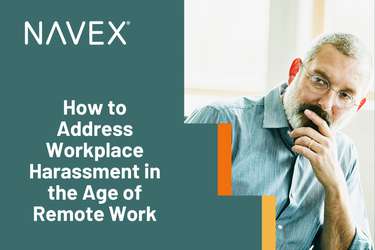This blog is part of the You Can't Delegate Ethics campaign. The campaign posits that systemic change on the issue of sexual harassment will occur only when good people in power take responsibility for the issue and create workplaces that do not tolerate it.
Sexual harassment is not a new issue. However, awareness of, and tolerance for it has evolved in recent years. What’s different now is that we have reached a tipping point – a reckoning, if you will – for organizations and their leaders.
The power is beginning to shift from the organization to individuals who are not just speaking out, but also being heard.
Over the past year, there has been a transfer of power over the narrative around this issue. The power is beginning to shift from the organization to individuals who are not just speaking out, but also being heard. Movements like #Metoo and #Timesup are empowering and emboldening individuals all over the world to demand a workplace free from sexual harassment. But as we all know, this is less about compliance with the law, and all about organizational culture.
Sexual Harassment is Either Permitted or Prevented by Culture
Understanding that sexual harassment is a workplace culture issue is the first step. The recent convergence of heightened awareness and the demand for change gives management the opportunity – and responsibility – to listen more closely and take active steps. But make no mistake, this is no longer about what is happening. It is about who is doing something about it. Leaders, you can’t delegate ethics on the issue of sexual harassment. And the reality is that everyone in your organization plays an important role in stopping the cycle of harassment. Consider what role you and other leaders play in stopping and preventing sexual harassment in your organization. Next, consider what role all employees can play, then ask them to help you create the culture everyone needs.
Sexual harassers are individuals, but culture is everyone. And in most cases, there are actually four parties involved: the perpetrator, the target, bystanders and senior management. When all actors are considered, and all do their part and hold others accountable, you can create a culture where harassment is not tolerated. So what does this look like and what should you expect of everyone in your organization?
Perpetrators are addressed. First, let’s discuss the perpetrators. Some are inconsiderate, cruel, and abusers of power – and those employees must be held accountable for their actions and must pay the consequences for poor decisions, no matter how harsh it may seem. Others may be inconsiderate or simply say something offensive. Regardless, their behavior must be appropriately addressed; when you tolerate harassing behavior you leave a lasting stain on your culture that is hard to erase.
In a healthy culture, managers will address this conduct, and coworkers will even step up to call the perpetrators out.
In a healthy culture, managers will address this conduct, and coworkers will even step up to call the perpetrators out. Employees will also grow more comfortable calling out even less egregious forms of sexual harassment or disrespectful behavior, helping reinforce that all forms of harassment are unacceptable.
Management’s role: Be a strong role model – don’t engage in harassing behaviors and don’t tolerate it from anyone (employees, peers, leaders, or business partners). Take reports seriously. Investigate, then take swift, decisive action including exiting the harasser if necessary. Make protecting the health of the whole organization the priority.
Those subjected to harassment are supported. Employees who are targeted by harassers need to know that management has their back. This means that they trust the reporting systems will work, and can expect the following from management: it will be fair and will work to identify and address any issues; it will not pre-judge them or place blame on the victim for the harasser’s bad behavior; it will prevent and put an end to retaliation. Finally, they must trust that their organization cares about providing a workplace free from harassment. This is a tall order for many organizations, and honestly, where most organizations fail their own employees.
If there is even a perception that there’s a professional price to pay for exposing sexual harassment, people won’t do it. And the cost for silence is a high one to pay for an organization.
Employees must be allies not bystanders. Managing the cycle of harassment cannot just be about dealing with the target and the harasser. If we want to solve this persistent workplace problem, we must focus on all of us – including bystanders (those who witness it and hear about it). For far too long, harassment has been treated as a personal issue (not a systemic culture failure) and bystanders have not felt empowered or obligated to speak up. That must change. Speaking up can be difficult for some, and there are lots of reasons why employees choose not to. But in a healthy workplace, all employees feel a sense of ownership over the culture and call out behavior that undermines it. If leadership values a strong culture, it must count on bystanders to speak up, especially in the case of sexual harassment.
Management’s role: Give people “permission” to speak up by making it an expectation. Make it known that calling out those who are out of line is exactly “what we do here.” Communicate and reinforce this through every means available, including your own behavior, until it becomes a cultural norm. Start by setting the tone and making it clear to all your employees what type of interaction is acceptable and what is not.
Steps Toward A Solution

To help initiate a more thoughtful conversation about sexual harassment’s effect on workplace culture – and culture’s central role is stopping it – NAVEX Global is producing a series of informative videos. The first encapsulates the story described above: how a healthy culture takes responsibility for stopping sexual harassment.
This video, and those that will follow in the coming weeks, is free to any organization interested in its message. It is yours to share with all of your employees, especially those in senior management. We hope it gives everyone something to think about and start acting on.









